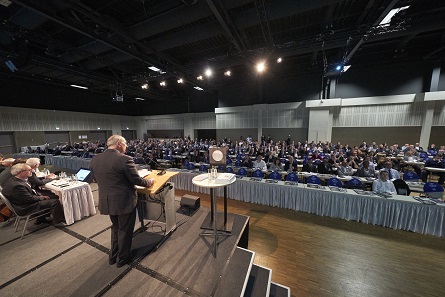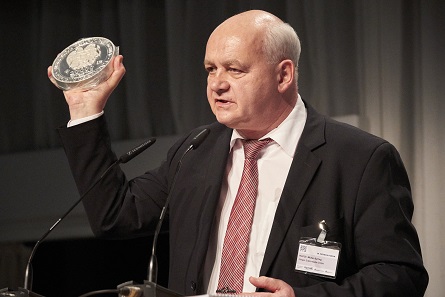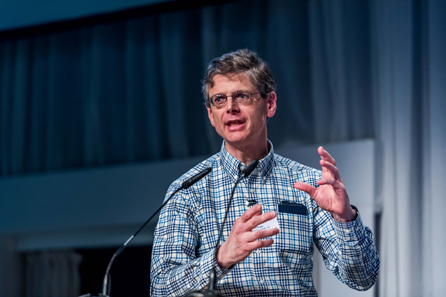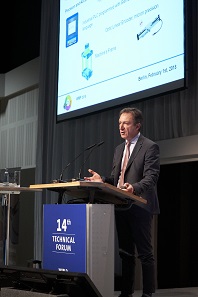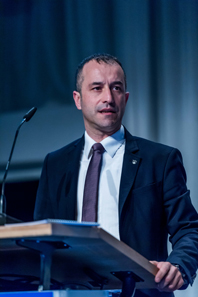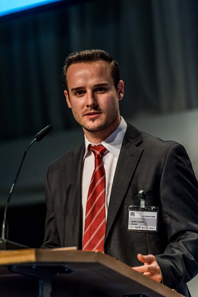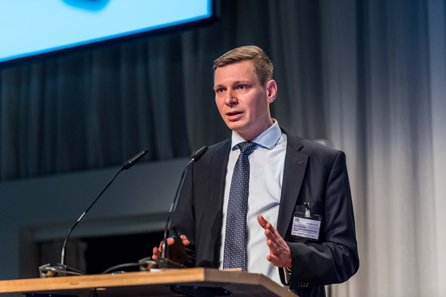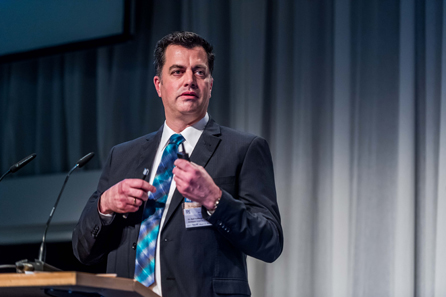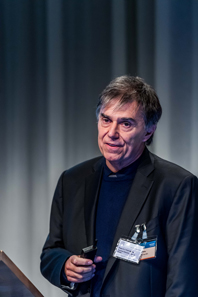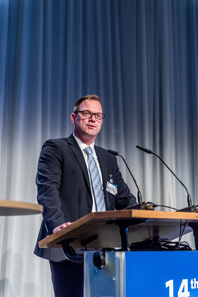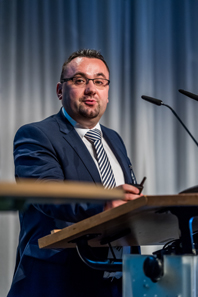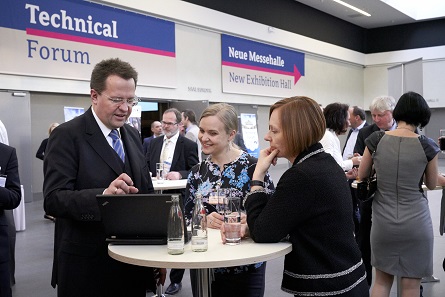by Ursula Kampmann
translated by Christina Schlögl
March 8, 2018 – The Technical Forum of 2018 saw a lot of change. People already knew the new and bigger room, where the presentations were held, but for the first time this year, the organisers of the World Money Fair reserved a convention hall close to it specifically for the booths of the supplying industry. The exhibitors really benefitted from this, because it kept the public visitors from blocking the way of potential customers to these booths. In addition, the slightly changed opening hours were appreciated by everyone. The traditional welcome of the Technical Forum took place in the new room, so that the first business conversations at the booths could already happen on Thursday evening. The end of the WMF was moved up to Saturday evening, only(!) for the supplying industry. All attendees of the convention really welcomed this change.
The speakers gave their talks in front of a full house. Photo: WMF / Andreas Schölzel.
Despite the new entrance fee: no decline in the number of visitors
Another innovation had been anticipated more sceptically. For the first time, the organisers charged an attendance fee for a seat in the Technical Forum. Many people were unsure if this would impact the number of participants. But the number was actually similar to the number of 2017: There were 410 attendees.
A well-established team: Dieter Merkle from Schuler (l.) and Thomas Hogenkamp from Spaleck (r.) hosted the Technical Forum. Photo: WMF / Andreas Schölzel.
They were presented with a diverse program with a focus on the most recent technology of coin inspection. Dieter Merkle of Schuler and Thomas Hogenkamp of Spalek, who took turns hosting the forum, presented an exciting variety of topics of the latest technological innovations to the audience.
Dr. Rolf Müller-Syring talked about minting the giants. Photo: WMF / Andreas Schölzel.
The really big ones
“Managing the Giants” was the title of the first talk by Dr. Rolf Müller-Syring and Dr. Jens Kirste. They gave an overview of the technical capabilities of the Geiger Edelmetalle GmbH. As an example, they used a big silver bar in coin shape which did not only stand out due to its inkjet printing, partial golding and an exceptionally high relief, but also due to its surface finish in “black proof”.
Geiger plans on extending its portfolio of minted metals. In 2017, they had added titanium. For 2018, the aim is to also process the metals bismuth and indium. Geiger is also working on a bimetal coin with a silver core and a titan ring which is a pre-stage to a trimetal coin.
The company has especially invested in developing its security features. Every ingot has a printed serial number and an intricately designed obverse, reverse and rim to make forging the ingots as difficult as possible.
From now on, Geiger will be delivering its bars of up to 100g in a capsule. American customers in particular are already used to this from grading companies. Larger series come in tubes or wooden boxes which are protected by a security seal. In addition, all bars are marked with a UV-print in form of the logo which is only visible under a black light.
As you can see, there is a lot of technology these days and it is also used with bars.
Dr. John Briggs from the Fraunhofer Institut USA reported on a new method of producing blanks, the Pushback Blanking (PBB). Photo WMF / Andreas Schölzel.
Blank production at the US-Mint: How to prevent annealing
There are 10 huge furnaces in Denver and Philadelphia, which have been used to put all blanks through the process of annealing. These furnaces are now drawing their last breaths. They really need to be replaced. Or could there be a method which would make their use after the stamping of the blanks redundant? The US-Mint posed this question. Richard Robidoux from the US-Mint and Dr. John Briggs from the Fraunhofer Institut USA have now reported on Pushback Blanking (PBB), a new method of producing blanks. The basic problem is that a blank which is punched out of a coil that was annealed in the traditional way by the manufacturer is always slightly concave and cannot be used for minting. People were thus looking for a way to avoid this problem.
In order to achieve this, the pushback process is now divided into two parts: During the first pushback process, a flat pushback pad attached to a spring exerts pressure, which leads to a blank with a flat surface and keeps it in the coil. The blank is only punched out of the coil in a second step.
Using this method for circulation coins has proven its efficiency: As of now, the US-Mint has minted more than 50 million circulation coins on blanks which were manufactured with the PBB-method. There is thus no need to buy new furnaces anymore.
Dr. Giulio Locatelli introduces his new oil-hydraulic press. Photo WMF / Andreas Schölzel.
A new oil-hydraulic press from Italy
Dr. Giulio Locatelli from the Italian mechanical engineer Locatelli Meccanica has introduced its new SH-300, an oil-hydraulic press which is characterised by its precision and its energy efficiency. In automatic mode, this special press allows for up to 7 objects per minute.
Julian Verdi (Tera Automation) explains his vision of “Industry 4.0”. Photo WMF / Andreas Schölzel.
Industry 4.0
Another Italian machine builder is Tera Automation. Julian Verdi talked about the meaning of the buzz word “Industry 4.0” for his company.
The secret is that data is collected in all locations and reported to a single spot. For example, an interconnected software could calculate, how much material was used in order to reorder more supplies in due time, while also sending a message to the client that his delivery – for instance – might take longer because there were shipping problems with the material.
People can both supervise and intervene in the production from the outside.
The analysis of such a large amount of data can be utilised for future decisions.
Even though this concept seems to be inevitable in terms of productivity, it does raise philosophical issues. After all, the idea behind “industry 4.0” is to make humans redundant. But the question is: What do we do with all these redundant people?
Well, Theodor Fontane would say: That would be too wide a field – and the Technical Forum surely isn’t the place to discuss this question.
Héctor Lorente of Sempsa presented how digital cameras could be employed. Photo WMF / Andreas Schölzel.
Automated quality inspection
Three speakers dedicated their talks to questions on automated quality inspection. Héctor Lorente of Sempsa spoke about the use of digital cameras, which utilise photometric stereo to create a three-dimensional image of a blank and are thus better able to display and evaluate potential flaws. This visual inspection system is paired with an automated packing system that operates contact-free in order to prevent further damage to the blanks.
Dr. Svorad Stolc (Austrian Institute of Technology) declared to have re-invented coin inspection. Photo WMF / Andreas Schölzel.
Dr. Svorad Stolc from the Austrian Institute of Technology (AIT) even declared that they re-invented coin inspection. The newly developed digital camera of the AIT does not just take a picture of the minted object but several pictures in a row which are all taken with constant illumination. The system thus creates a two-dimensional and a three-dimensional image of the object: This allows for a traditional control of the blanks and the minted coins, but also control of the security features like latent images or surface features. Dr. Stolc stated that the system was easy to handle and worked extremely fast, since it was based on the world’s fastest multi-line scan camera, developed by AIT. The system allows for an inspection of up to 3,000 coins per minute.
Dr. Ralf Freiberger from Mühlbauer informed about new ways of finding counterfeits of circulatoin coins. Photo WMF / Andreas Schölzel.
Dr. Ralf Freiberger from Mühlbauer rather targeted his presentation at people who check circulation coins for counterfeits. There is a new feature in the machine “Coin Inspect” which takes exact measurements – diameter and thickness – at several points of up to 3,000 objects per minute.
The “Coin Text Station”, which can process 10 objects per minute, can even determine the composition of a coin using X-Ray Fluorescence. The exact analysis of a coin’s relief makes it possible for the machine to detect and reject specimens that were minted with a copied die.
New high speed counting
The company Velec and their VELEC SB600 has reached a new dimension of coin counting speed. Large coins generally cause problems during high speed counting. While the counting speed for smaller coins can be accelerated by an increase of rotation speed in which the centrifugal force transports the coins through the system, this does not work for larger coins. If the centrifugal force becomes too strong, the coins are no longer transferred to the opening where the coins are actually counted. As a result, the efficiency of counting coins with larger diameters does not increase but decrease when too much centrifugal force is used.
Velec has now developed a new method which also utilises centrifugal force for counting larger coins. Their newly patented machine can count up to 8,000 coins per minute. This is applicable to coins with diametres between 13 and 40 mm and 0.9 to 4 mm thickness.
Prof. Paulo Martins presented a computer program which optimises the calculation of material flow by means of the finite element method. Photo WMF / Andreas Schölzel.
Finite elements and correcting die profiles
Nowadays, trial strikes are often made redundant by computer programs that analyse the dies’ depiction and their impact on the material. The Portuguese mint INCM has developed a new computer program in association with Técnico Lisboa which optimises the calculation of material flow by means of the finite element method. Prof. Paulo Martins introduced the program in his presentation.
The new procedure integrates a stack compression test, which determines the stress-strain curve directly from the blanks. Using dies that were altered according to the computer program, one can not only reduce the applied pressure and the minting force, but also extend the die life.
Michael Groves (Royal Canadian Mint) showed an alternative of how avoiding expensive trial strikes. Photo WMF / Andreas Schölzel.
The Royal Canadian Mint has occupied itself with the same problem, as Michael Groves reported. They have developed their own method and they have used a highly complex project to demonstrate its efficiency: The commemorative coin for the 125th anniversary of the Stanley Cup, which is a halved replica of the trophy in miniature format. Therefore, the commemorative coin has an extremely high and complex three-dimensional relief and a completely irregular shape. Minting coins like these is only possible because of a completely new technology by the Royal Canadian Mint. This technology can be used to produce reliefs of up to 6 mm.
In order to mint such an object, one would normally have to create time-consuming and expensive trial strikes. Thanks to the computer program, production has become much quicker and much simpler.
Siemowit Kalukiewicz (Mint of Poland) demonstrated what variety of shapes coins could have in the future. Photo WMF / Andreas Schölzel.
News from the Mint of Poland – and which lasers make their products possible
What more is there to see after commemorative coins in the shapes of cylinders, pyramids, globes, eggs and bells? Siemowit Kalukiewicz discloses it. In 2017, the Mint of Poland produced a fish whose tail is flipped. Consequently the pressure for striking has to be exerted from above, from the side and from below. First, special blanks in fish shape are produced for this. Their tail is already curved. The blanks are the minted with a complex, multi-piece die that consists of four elements: An upper die, a lower die, a side die and an internal die.
We are excited to see what the Mint of Poland will come up with next year.
Whatever this innovation will be, it will probably start with dies that were engraved with the ACSYS laser technique, as Alexander Aminidis said. He showed how easy the engraving of a die with a shaped surface can be. With the help of the new dynamic focus control, the laser can transfer a design from a flat surface onto any shaped die surface. This new feature can be integrated into nanosecond- and picosecond lasers. Picosecond lasers show better and faster results with engraving, while a nanosecond laser offers more opportunities for fine frostings.
Dr. Manfred Matzinger-Leopold from the Münze Österreich is talking to colleagues from the Mint of Finland. Photo: WMF / Andreas Schölzel.
The following reception, which took place in the new convention hall for the supplying industry for the first time, was a welcomed opportunity to talk about the presentations and discuss the latest technological developments.
You can find the full program of the Technical Forum here.
All speakers’ presentations will be available for download on the World Money Fair’s website. There, you will also find all presentations from the previous years.
This is our report on the World Money Fair.
If you would like to witness the awarding of the Coin of the Year Award, please click here.




